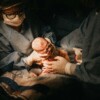
Every Life is on Fire: How Thermodynamics Explains the Origins of Living Things
The question of how life began strikes at the heart of the intersection of philosophy and science. Every Life is on Fire: How Thermodynamics Explains the Origins of Living Things presents a complete overview of England’s theoretical model of dissipative adaptation and how it relates to the origin of life. Unlike other books written on the origin of life, England uses an approach based primarily on physics, instead of biology. Another differentiating factor is that England is not analyzing a summary of different theories developed by other scientists and philosophers on the origin of life; he is presenting his own scientific work on the matter along with his thoughts on its philosophical implications, with a focus on refuting secular arguments that life from inanimate matter discredits the notion of a Creator. This makes it a unique read among the wealth of literature on the subject.
The book is primarily about the theory of dissipative adaption. This is a theory that proposes to explain how life could stem from lifeless matter. Dissipative adaption comes from the study of thermodynamics and entropy. In this theory, matter self-organizes in a way that allows for the greatest absorption of energy. This in turn leads to inanimate matter arranging into a pattern that has a life-having arrangement. Based on the laws of entropy this leads to irreversible processes that England theorizes could lead to understanding how life came to be. This book is an extended version of his 2015 paper on the subject.1 Simply, the theory begins with matter. When energy is added to that matter, it begins to self-arrange into a state that becomes alive.
In the introduction, England anticipates the implications of the theory of dissipative adaption within the atheist community. For many secularists, evidence that life can arise from previously lifeless matter is a much sought-after result that in their minds discards the need for God. Richard Dawkins is cited as one such individual.2 Thus, England brings in the miracles of Moses. In these miracles, God brings life from lifeless objects; for example, a staff is made into a snake. Each of England’s chapters ends by recounting a particular miracle within the Exodus narrative. These serve not as evidence of dissipative adaptation but merely to demonstrate that Judeo-Christian thought already accommodates acceptance of life developing out of inanimate matter. For England, this serves primarily as a challenge to atheists to find a more robust argument against God and secondarily to comfort theists that they need not have fear of the implications of dissipative adaptation. England never yields to the God-of-the-gaps argument, nor does he make stronger philosophical statements that might progress beyond the limits of dissipative adaptation. This is a quite commendable feat rarely seen in science and faith literature. England concludes the book by implying that there are aspects of the world that are not as random as we might suppose, and in this we could choose to see something deeper and more meaningful. This too serves as a challenge to secularists and as comfort to the religious.
The miracles focused on by England to complement his theoretical explanations of dissipative adaption are intentionally chosen. The first is the staff and the snake. This is an example of lifeless matter becoming something alive and breathing. England uses this analogy to remind the audience that the biochemistry that makes life possible is made of the same bits that physicists use to study entropy and phase transitions. While physics can be used to describe matter, some of which may comprise a living creature, physics has no mechanism to define what makes something alive. Moses’ “snowy” hand is also referenced as a demonstration of healthy living flesh becoming sickly. Further, England used snowy skin afflictions to discuss snow, the weather phenomenon. He reminds the readers that avalanches are comprised of several individual snowflakes. This analogy carries the understanding that living creatures, as well as inanimate matter, are a collection of atoms with a particular arrangement. Parts of beings and things made of pieces can be taken apart and possibly re-assembled. England uses the miracle of the Nile being turned to blood as another example of life from non-life as blood is considered by most cultures to be the life fluid. The flaming bush that is not consumed is used to show that both the bush and the flame are a part of expected experiences and thus one could imagine the states of matter arranging in such a way as to elicit such an event. (In quantum mechanics, many things are possible, but not all are probable.) These comparisons are somewhat effective in guiding a reader through an experiential understanding of the implications of dissipative adaptation.
One striking aspect of Every Life is on Fire is the beauty of its prose. England has a poetic touch when crafting even the most technical arguments. There is an artistry in the way he arranges words. While uncommon in most nonfiction work, it is particularly rare in popular science. This fine writing is an unexpected delight and in many ways enhances some of his arguments. Further, the imagery of his prose alludes to something existing in this world beyond the physical, thus presenting an artistic bit of support for his thesis that dissipative adaption is compatible with a universe made by a Creator.
One limiting aspect of this book is that it is not very accessible to a lay audience. In order to follow the scientific arguments, one would need to have a background in physics, biochemistry, and/or mathematics. Much of the physics discussed, like the Crooks theorem, is not covered until a physics student reaches graduate school. Another challenge of applying his theory is that physics has no meaningful definition of “alive.” However, the aliveness or deadness of a creature is something that we are all intrinsically aware of and capable of recognizing ourselves. England does employ analogies to explain his theory in a way that a non-scientific audience might be able to grasp, but he is not entirely successful. This makes it challenging for an individual outside of STEM to assess the scientific validity of the arguments. While the integration of scriptural passages is interesting, the analogies are often clunky and incomplete without theoretical understanding. The book does contain a short discussion of the philosophical implications of this theory’s explanation for the beginning of life; however, it is clear that England’s discipline is biophysics, not philosophy. There is not enough material here to thoroughly engage the philosophical implications in a meaningful way.
When analyzing the arguments presented by England, there are a few things to keep in mind. His theory is a model. It is still undergoing the process of empirical testing and thus caution is recommended on integrating this model into theological conversations. Just as England warns atheists from lazy argumentation, so should Christians exercise the same caution. This book does an exquisite job at illustrating how the approach of physics to analysis differs from other scientific disciplines. Physics depends on accurate equations to predict future states of matter; thus, it is limited to smaller systems. This is different from other science fields like chemistry and biology. As increased computing power expands the horizons to which physics methods can be applied, this limiting factor may be overcome. Additionally, as noted, physics has no equation for determining that something is alive; thus, when synthesizing the theory, it is necessary to do so within the confines of physics. Should the theory of adaptive dissipation prove to be scientifically robust there will be implications in biochemistry and biology. These interdisciplinary bridges are still being built, and we should approach the integration of physics with other disciplines with curious humility.
Further research and the rigor of the empirical testing process of new theories will eventually give clarity to the strength of the theory of physical dissipation. This will be interesting to watch as the evidence comes forward. England’s work in physics and biochemistry will certainly make a long-lasting impact on the field. With new scientific evidence, theologians and philosophers will need to grapple with implications to the understanding of what it means to be alive and made in the image of God. England makes a critical point that, although distinct from the scientific debates that will follow, a deeper scientific understanding of the origin of life does not negate the existence of Creator God, nor does it deny God’s desire to have a relationship with that creation.























